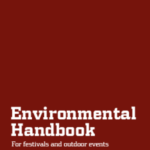Environmental Impacts
Environmental impacts are those concerned with the built and natural environment, including air, water and biodiversity. Events cause impacts resulting from activities such as construction, energy use and transport of spectators and participants, which in turn impact on major environmental issues such as climate change and the reduction in natural resources.
1. Integrating Environmental Considerations
There are environmental impacts from an event throughout the period of preparation for the event, as well those during, and concluding, the event. For many types of impact, the larger the event, the greater the negative environmental impact. Decisions made at the early planning stage can significantly influence the types of environmental impacts that arise from the event. Therefore good practice is to establish a baseline environmental assessment at the start of the preparation phase, and a plan to deliver the event with environmental sustainability at the heart of all decision making. Policies put in place to address environmental issues also need to take account of the actions of suppliers, for example through green procurement policies.
Where major events involve the construction of new built environment, there are specific guidelines and best practice for green construction, for example through LEED certification.
2. Possible Outcomes
a. Environmental Quality – the nature of major events having significant media attention in the build-up to the event, provides an opportunity for them to demonstrate leadership of environmental best practice and standards, such as waste recycling, which may be adopted more widely by other organisations in the host nation after the event.
Example Output KPIs
• New environmental standards or innovations adopted within host nation
b. Climate Action – very large scale multinational events with media exposure to a wide audience, also provides an opportunity for positive leadership and action to address climate change, which can in turn support multinational co-operation for this global issue.
Example Output KPIs
• New renewable energy generation sources
3. Inputs
Good practice is for major events to address environmental issues within the sustainability plans at the start of the preparation phase. Key areas to be considered are;
a. Waste – One of the most visible environmental impacts arising from a major event. However, volumes, nature and destination of waste associated with an event, either as part of infrastructure development, event operations or visitor consumption are complex to measure. This is due to the mix of responsible agents from venues, local authorities, organisers and suppliers, to spectators and participants.
Example KPIs
• Proportion of waste diverted from landfill (including recycling, composted)
• Proportion of food and drink containers made from recyclable/biodegradable material
• Proportion of signs, banners, tents etc. that can be used for multiple years
b. Energy – Energy use during the preparation and delivery of a major events takes different forms, whether from the construction of venues, energy consumed by spectators travelling to an event, or energy used in running event venues. Critical is to minimise the proportion of this energy developed through the use of fossil fuels due to the impact on climate change from greenhouse gas emissions. As a result, the practice of calculating the carbon footprint of an event is becoming more common. This is a useful tool to identify opportunities for avoiding and reducing greenhouse gas emissions. Carbon offsetting can be used to offset any unavoidable emissions through ‘carbon compensation’ schemes.
Example KPIs
• Proportion of energy sourced from renewables or purchased through energy providers’ green power programme
• Quantified emission reductions against baseline carbon footprint
• Total event carbon footprint (CO2 equivalent)
c. Water – Increasingly water is becoming a scarce resource in many host communities, if only at certain times of the year. Therefore reducing water consumption is a key issue for sustainable development and an area of focus for major events, both in preparation for, and during, the event.
Example KPIs
• Proportion of water used from sustainable sources, e.g. rainwater harvesting
d. Transport – Transport can be one of the most complex aspects of hosting a major event and a large contributor to costs, greenhouse gas emissions, and reduced air quality. Encouraging people to use greener transport modes to get to and from events reduces travel time, traffic congestion, greenhouse gas emissions, and parking issues.
Example KPIs
• Proportion of visitor journeys by public transport
• Proportion of visitor journeys by sustainable travel (e.g. cycling, zero-emission vehicles)
e. Natural Capital – Open spaces created as part of new construction for major events can have a significant impact on local ecosystems. Healthy ecosystems provide numerous benefits, such as amenity, mitigation against urban heat island effects, flood alleviation, soil stability, improved air quality and soundscape, and food production.
Example KPIs
• Environmental safeguards put in place, e.g. pollution prevention measures
• Net gain in accessible greenspace
CASE STUDY
 This PDF is an extract of a study conducted by Sportcal on the Hempel Sailing World Championships Aarhus 2018. This section focuses on the United Nations’ Sustainable Development Goals and the spectator awareness of environmental considerations.
This PDF is an extract of a study conducted by Sportcal on the Hempel Sailing World Championships Aarhus 2018. This section focuses on the United Nations’ Sustainable Development Goals and the spectator awareness of environmental considerations.
A comprehensive sustainability programme was delivered at the Hempel Sailing World Championships Aarhus 2018. The Aarhus 2018 Organising Authority partnered with foundations and commercial organisations in order to establish a sustainability plan for the championships that was in line with World Sailing’s sustainability policy entitled Sustainability Agenda 2030. World Sailing, the governing body of the sport, had aimed to use the event to set a baseline for some of its sustainability initiatives.
GUIDANCE
This handbook produced by the Øya Festival enterprise offers guidance on how to organise the environmental work within a large event, with suggestions for concrete measures that can be taken. In the handbook you will find tips and advice on everything from waste handling and the use of energy to making lists of suppliers of environmentally sound products and services. Most of the examples are taken from Øya’s environmental work. The festival wishes to contribute with a conscious environmental profile from the hammering of the first nail, to the recycling of the last plastic cup. The idea is that environmental awareness colours the entire organization. The goal is to continue being a national and international spearhead as environmentally friendly festival organizer.
4. Glossary of Terms
Biodiversity
The variability among living organisms from all sources, including terrestrial, marine and other aquatic ecosystems and the ecological complexes of which they are part; this includes diversity within species, between species and of ecosystems. A high level of biodiversity is usually considered to be desirable and important to all species’ survival.
Carbon footprint
The measurement of greenhouse gas emissions attributable to an event or activity, expressed as tonnes of carbon dioxide equivalent which allows the different greenhouse gases to be compared on a like-for-like basis relative to one unit of CO2.
Carbon offsetting
Where individuals and organisations mitigate their emissions by investing in projects that avoid the production of carbon or remove it from the atmosphere.
Climate change
The term used to describe the change in global or regional climate patterns, in particular attributable to the increased levels of atmospheric carbon dioxide produced by the use of fossil fuels.
Greenhouse gases
Gases that trap heat in the atmosphere are called greenhouse gases. The principal greenhouse gases are carbon dioxide (CO2), methane (CH4), nitrous oxide (N2O) and fluorinated gases, such as hydrofluorocarbons (HFCs).
Green procurement
The purchasing of environmentally friendly products and services, and the use of environmental requirements in the selection, and contracting, of suppliers.
LEED certification
A third-party verification process in order for structures to be considered “green,” or environmentally friendly. LEED stands for Leadership in Energy and Environmental Design, is focused primarily on new, commercial-building projects and based upon a points system, see http://leed.usgbc.org.
